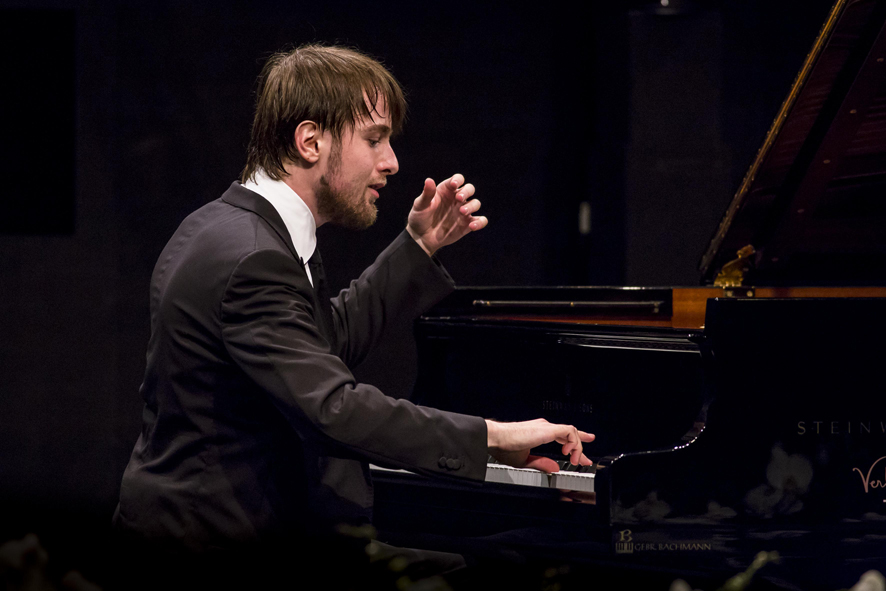Trifonov’s prowess on full display with Urbański, Houston Symphony

If one compiled a list of classical music’s most-mistreated works, Tchaikovsky’s Piano Concerto No. 1 would rank high, and Mussorgsky’s Pictures at an Exhibition might come close behind. Each suffers at the hands of performers who turn its theatrics into bombast.
But the Houston Symphony gave back both works their dignity and freshness Friday night at Jones Hall, with the help of guest conductor Krzysztof Urbański and pianist Daniil Trifonov.
Led by Urbański, the strings eased into the concerto’s famous opening tune, sidestepping force in favor of smoothness and gleaming tone. Trifonov complemented the orchestra by making the piano’s chords bright and clear, not thunderous.
When the piano took over the big theme, Trifonov swept through it in bold, ringing phrases, but he avoided mere breast-beating: Midway through the keyboard’s flourishes, Trifonov pulled them back from fortissimo to a hush, setting up the orchestra to have all the more impact when it brought back the introductory tune for the last, most sonorous time.
For the rest of the movement, Urbański, Trifonov and the orchestra brought out Tchaikovsky’s lyricism, avoided bluster yet preserved the concerto’s electricity. The strings, guided by Urbański, brought lilt and silkiness to their gentle theme later in the movement. But the entire orchestra filled buildups and climaxes with depth and grandeur.
Trifonov’s agility and lean, brilliant tone gave the piano’s flights of virtuosity a visceral impact, yet even the most flamboyant gestures had musical shape — rather than coming across as mere machine-gun blasts, as they do with some pianists. And Trifonov treated the introspective moments to a tenderness and transparency that were as arresting in their way as the pyrotechnics.
The Russian pianist’s subtleties came to the fore in the slow movement. He spun out the serene main melody in simple, almost crystalline phrases; as the music unfolded, he filled it with deft, airy touches, whether the piano was leading the way or blending with the orchestra.
Woodwind soloists lent the music their own sweetness — except for the oboe’s highest phrases, which turned piercing — but Urbański also spurred the group to take off at a whirlwind pace in the movement’s middle section. Thanks to Trifonov’s fleetness, the keyboard filigree were every bit as breezy.
Whereas some pianists take off into the finale’s rambunctious opening with walloping force, Trifonov went at it briskly but lightly — again paving the way for the orchestra to make a bigger splash when it took over.
He soon added his own dynamism and rumbling tone to Tchaikovsky’s rowdiness. And when the orchestra switched to the majestic, sonorous mode for the concerto’s last burst of big-tune splendor, Trifonov complemented the group with the ring of the piano’s chords.
After several curtain calls’ worth of insistence from audience applause, Trifonov countered Tchaikovsky’s dramatics with the introspection of a little-known Russian gem: “In a Monastery” from Alexander Borodin’s Petite Suite. Trifonov’s subtle brush-strokes filled the tolling chords and fine-spun lyricism with atmosphere.
After intermission, Urbański and the orchestra relished the tone-painting of Ravel’s orchestration of Mussorgsky’s Pictures. From the first notes of the opening “Promenade,” the brasses’ mellowness and sleek lyricism hinted that, here as in the concerto, crudeness would be out.
The brasses captured the gloom and eeriness of “Catacombs” without snarling: The contrast between commanding, dark-hued chords and hushed ones did the trick. At the opening of the climactic “Great Gate of Kiev,” the orchestra conjured up the music’s majesty without having to pull out all the stops: Fullness and breadth, rather than decibels, created the aura. That made it all the more potent when the orchestra ultimately capped off the movement — and the whole suite — with its most brilliant, pealing tones.
Along the way, Urbański brought out the orchestra’s vividness with often-minimal gestures. As the group filled “Tuileries” and “Ballet of the Chicks in Their Shells” with buoyancy and brightness, Urbański’s arms and hands at times hardly moved. But he still added a touch of coziness to the strings’ theme in the middle of “Tuileries,” relaxing the pace a bit to let the players caress the airy turns of phrase; in one or two of those turns, Urbański didn’t have the players quite together, but the effect still came through.
Decisive strokes, rather than podium histrionics, were all it took for Urbański to unleash the orchestra’s vigor and impact amid the grotesquerie of “Gnomus” and the ferocity of “The Hut on Fowl’s Legs.” At the other extreme, he led the strings to suffuse “The Old Castle” with glistening, diaphanous tones that exuded aural moonlight–and the saxophone’s tender singing completed the nocturnal scene.
Urbański and the orchestra opened the concert with a much more recent piece of tone-painting: “Celephaïs” from The Cities of Lovecraft by Guillaume Connesson, a Frenchman born in 1970.
Inspired by a story by H.P. Lovecraft, an American author of horror and fantasy tales, “Celephaïs” describes a dream-world city that features streets paved with onyx, pagan revelries and a procession of priests wreathed with orchids. The nine-minute score’s ingredients range from a surging violin theme to salvos of blazing brasses and glittering winds, and Urbański spurred the orchestra to fling out every sonic burst with gusto.
The program repeats 8 p.m. Saturday and 2:30 p.m. Sunday in Jones Hall. houstonsymphony.org; 713-224-7575